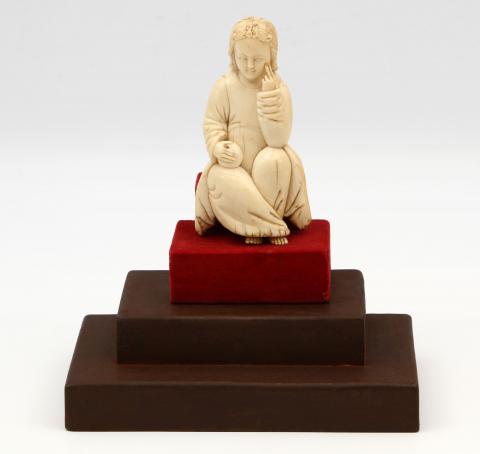Menino Jesus Salvador do Mundo
Seated Baby Jesus Salvatore Mundi
China, Ming Dynasty, 16/ 17th Century.
H.: 9 cm
Prov.: P.C., Barcelona;
Exhib.: ‘Venans de Loingtaines Voyages » Bordeaux, 2019, p. 42
Menino Jesus Salvador do Mundo
Marfim
China; Dinastia Ming / Qing, séc. XVII
Alt.: 9,0 cm
The physionomy of the face belies the Chinese influence with its serenity and expression, denoting deep spirituality and mysticism. The head has a high forehead, the hair with a central parting, is styled in the Buddhist manner with large curls to the front, a sign of superior intelligence, with the locks falling to the shoulders carved in fine parallel lines, terminating in stylized ringlets. The eyes are round and slightly protruding, set in deep sockets, with the mouth beautifully delineated and lips slightly parted.
One hand holds the terrestrial Globe as befits the Saviour of the World, and His face rests lightly in the other, with the index and middle fingers extended in the way of blessing acknowledged as dignified and majestic in Europe.
He is seated in an Oriental manner vested in a simple tunic without decoration, yet crafted in a way that delineates His body and shows the seated form and crossed legs. The feet are crossed yet remain side by side, in the Chinese fashion.
Menino Jesus sino-português em marfim, do séc. XVII.
De grande qualidade escultórica, o menino encontra-se sentado em atitude de profunda meditação.
A face é serana, esboçando leve sorriso e os cabelos lisos terminando em suaves caracóis.
Está sentado, com sa pernas cruzadas à maneira oriental, desixando ver as pontas dos pés, segura na mão direita a orbe terrestre. A mão esquerda toca na face e o cotovelo está apoiado no joelho.
Veste túnica simples, desprovida de qualquer adorno, comprida, deixando ver as pontas dos pés descalços e cruzados à maneira oriental.
Face e cabelos com característicos traços orientais.
O encontro entre culturas possibilitou o surgimento de uma representação que apresenta incontestável influência da imaginária luso-oriental, mas que também se destaca pela incorporação de elementos da cultura local, propiciando um somatório de símbolos e significados que dão a estas imagens uma originalidade especial.
Muito utilizado na imaginária cristã, o marfim era o material ideal para elaboração dos objectos de pequenas dimensões. Abundante naquela época no Oriente, propiciou aos artesãos a realização de trabalhos refinados e subtis com grande nitidez de contorno, conferindo uma excelente qualidade plástica.
- Arte Colonial e Oriental
- Arte Cristã
- Marfins

